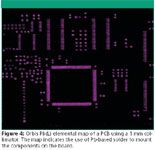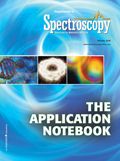The New Orbis Micro-XRF Analyzer Series
Building on more than 10 years of Micro-XRF experience, the Orbis spectrometer yields a system with excellent Micro-XRF capability while setting a new standard in analytical flexibility. The Orbis incorporates a unique motorized turret integrating video and X-ray optics allowing coaxial sample view and X-ray analysis. The turret can accommodate two additional collimators along with the X-ray optic for a total of three X-ray beam sizes to expand the Orbis analytical capabilities beyond traditional Micro-XRF analysis. Primary beam filters can be used with all spot sizes available on the turret to allow true XRF analytical capabilities in a micro-spot analysis. The working distance is increased to allow analysis over rougher sample topography without sacrificing signal intensity.
Building on more than 10 years of Micro-XRF experience, the Orbis spectrometer yields a system with excellent Micro-XRF capability while setting a new standard in analytical flexibility. The Orbis incorporates a unique motorized turret integrating video and X-ray optics allowing coaxial sample view and X-ray analysis. The turret can accommodate two additional collimators along with the X-ray optic for a total of three X-ray beam sizes to expand the Orbis analytical capabilities beyond traditional Micro-XRF analysis. Primary beam filters can be used with all spot sizes available on the turret to allow true XRF analytical capabilities in a micro-spot analysis. The working distance is increased to allow analysis over rougher sample topography without sacrificing signal intensity.
The Orbis is a tabletop unit with powerful, easy-to-use analysis software. Orbis users can make elemental analyses on small samples such as particles, fragments and inclusions, or automated multi-point and elemental imaging analysis on larger samples with all the benefits and simplicity of an XRF analyzer. Benefits include:
- Non-destructive measurement
- Minimal sample preparation (e.g. no sample coating is necessary)
- Improved sensitivity for many elements in comparison to SEM/EDS.
- Inclusion and coating thickness analysis with the penetrating power of X-rays.
- Analysis of wet samples.
Small Spot Analysis
Small spot XRF analysis is typically used for analysis of fragments, targeted analysis on larger components and high-resolution elemental imaging. The Orbis system can be equipped with a 30 μm ultra high intensity poly-capillary capable of providing fast, sensitive XRF analysis. Glass fragments are typically analyzed by micro-XRF for criminal and industrial forensic applications. With the Orbis' poly-capillary and primary beam filter system, fast, non-destructive analysis can be done with improved sensitivity at a spot size of 30 to 60 μm (FWHM) depending on the elemental X-ray energy.
In Figure 1, analysis of glass using the 30 μm poly-capillary and primary beam filters for comparative purposes and compositional analysis is shown. Analysis of Cl down to an LOD ~ 25 ppm was achieved using a filter to remove the overlapping Rh(L) tube scatter line.

Figure 1
In another example (see Fig 2), the Orbis poly-capillary is used to elementally image a portion of a fading black and white photo using the Ag(L) signal to digitize the image. This was done as part of an initial effort to evaluate the suitability of micro-XRF imaging for the archival preservation of Ag-based photos.

Figure 2
Large Spot Analysis
In a variety of analytical scenarios, XRF analysis using a larger analytical beam diameter is more advantageous than probing the sample with a small beam analysis. Analyzing inhomogeneous materials, for example, with a small probe beam yields information on the level of inhomogeneity of the material while analyzing with a large beam can give a compositional analysis more consistent with the average composition. A larger analytical beam is also useful for screening and searching large areas of a sample for specific elements. Good examples of this come from RoHS analysis and screening.
Plastic components used in electronic products are typically screened for the RoHS hazardous elements and compounds (Cd, Pb, Hg, Cr+6, certain Brominated fire retardants) using XRF. Plastics can be relatively inhomogeneous materials with respect to additive components. Average compositional analysis of trace elements in plastic is simplified by analyzing the sample with a large beam (see Figure 3).

Figure 3
Using a larger X-ray beam facilitates the speed at which larger multi-component samples can be screened for restricted materials. A typical example is the screening of printed circuit boards for Pb-based solders (see Figure 4). The printed circuit board can be elementally imaged using a larger beam size with lower pixel resolution. Potential problem areas identified by the elemental images can then be analyzed in more detail with a smaller beam size if necessary.

Figure 4
Conclusion
The Orbis micro-XRF spectrometer was developed with the mindset of providing a state-of-the-art micro-XRF analyzer with excellent analytical flexibility. The goals of the development were to provide the user with:
1) Access to both ultra-high intensity X-ray optics and larger beam collimators.
2) Primary beam filters at all spot sizes, small and large.
3) Improved elemental sensitivity.
With this analytical flexibility, the Orbis system is capable of providing solutions to a wide variety of problems suited to XRF analysis.

EDAX, Inc.
91 McKee Drive
Mahwah, NJ 07430
Tel. (201) 529-4880, Fax (201) 529-3156

A Seamless Trace Elemental Analysis Prescription for Quality Pharmaceuticals
March 31st 2025Quality assurance and quality control (QA/QC) are essential in pharmaceutical manufacturing to ensure compliance with standards like United States Pharmacopoeia <232> and ICH Q3D, as well as FDA regulations. Reliable and user-friendly testing solutions help QA/QC labs deliver precise trace elemental analyses while meeting throughput demands and data security requirements.